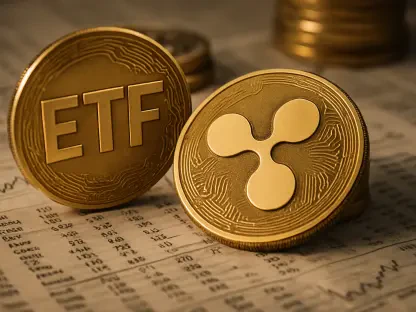The American stock market has taken a noticeable hit recently, stepping back from a series of record highs as investor confidence wavers under the weight of declining technology giants and cautious signals from the Federal Reserve. This downturn marks a shift from the bullish momentum that had defined Wall Street for several days, with major indices like the Dow Jones, S&P 500, and Nasdaq all recording losses. The Nasdaq, in particular, felt the brunt of the decline with a 1% drop, largely driven by significant pullbacks in heavyweight tech firms such as Nvidia and Amazon. Beyond domestic concerns, global economic indicators and geopolitical tensions are adding layers of complexity to the financial landscape. As markets navigate these choppy waters, the interplay of high valuations in tech, central bank policies, and international developments paints a picture of uncertainty that demands close attention from investors and analysts alike.
Tech Sector Struggles Weigh on Wall Street
The technology sector, often seen as the engine of recent market gains, has become a source of concern as major players stumble. Nvidia, despite a recent surge fueled by a $100 billion investment in OpenAI for cutting-edge AI infrastructure, saw its stock dip by 2.8%, reflecting broader investor unease about sky-high valuations in the mega-cap tech space. Amazon and other tech giants followed suit, contributing to the Nasdaq’s sharp decline. Analysts note a pattern of investors buying on dips during this rally, yet the persistent question remains whether these valuations are sustainable. The tech-heavy index’s retreat signals a potential cooling of the aggressive optimism that has driven Wall Street to record levels, prompting a reevaluation of risk among market participants who have grown accustomed to relentless upward momentum in this sector over recent months.
This pullback in tech stocks is not merely a numbers game but a reflection of deeper market dynamics at play. While investments in areas like generative AI continue to attract significant capital, skepticism lingers about the tangible returns on such massive expenditures. Industry observers highlight that the tech sector’s growth narrative, while compelling, faces scrutiny as investors demand clearer evidence of profitability and long-term value creation. The recent downturn serves as a reminder that even the most innovative industries are not immune to market corrections, especially when economic conditions and investor sentiment shift. This moment of recalibration could either pave the way for more measured growth or signal deeper vulnerabilities within the sector, depending on how upcoming earnings reports and technological breakthroughs shape perceptions in the near term.
Federal Reserve’s Cautious Stance Adds Pressure
Federal Reserve Chair Jerome Powell’s recent comments have introduced an additional layer of caution to an already jittery market. Emphasizing the risks of cutting interest rates too aggressively, Powell highlighted the potential for reigniting inflation while also stressing the importance of safeguarding the labor market. This delicate balancing act has left investors uncertain about the pace of monetary policy adjustments, contributing to a more conservative mood on Wall Street. The Fed’s dual focus on curbing inflation and supporting employment underscores the complexity of the current economic environment, where any misstep could have far-reaching consequences for market stability and consumer confidence across the board.
The impact of the Fed’s cautious rhetoric extends beyond immediate market reactions, shaping longer-term expectations among investors. With inflation fears still simmering and labor market data under close scrutiny, the central bank’s messaging suggests a prolonged period of vigilance rather than swift policy easing. This stance has prompted a reassessment of growth projections, particularly for sectors sensitive to interest rate changes like technology and finance. As markets digest these signals, the potential for volatility remains high, with traders likely to react sharply to any new economic data or Fed communications that hint at shifts in direction. This environment of heightened sensitivity to policy cues is a critical factor driving the current retreat from record highs.
Global Markets and Geopolitical Tensions
On the international stage, mixed economic signals are contributing to a fragmented global market outlook. In Europe, while London’s FTSE 100 held steady, Paris’s CAC 40 and Frankfurt’s DAX posted modest gains of 0.5% and 0.4%, respectively, buoyed by a 16-month high in eurozone business activity. However, weaker performance in France and disappointing purchasing managers’ index data in the UK point to uneven recovery across the region. In Asia, trading was muted due to a holiday in Japan and an approaching typhoon in Hong Kong, with declines in the Hang Seng Index and Shanghai Composite, contrasted by a surge in Taipei driven by chipmaker TSMC. These disparities highlight the localized nature of economic challenges and opportunities influencing investor behavior worldwide.
Adding to the global complexity, geopolitical tensions are impacting commodity markets, particularly oil prices. A recent push by former President Donald Trump for Europe to halt Russian oil imports over the Ukraine conflict, coupled with threats of sanctions, has driven up West Texas Intermediate and Brent North Sea Crude by 1.8% and 1.6%, respectively. This development, seen as a stronger stance in support of Ukraine, introduces an external pressure point to already volatile markets. The rise in oil prices could further complicate inflation concerns, affecting everything from consumer costs to corporate profit margins. As these geopolitical undercurrents intertwine with economic data, they create a multifaceted environment where global investors must navigate both regional disparities and broader international risks.
Reflecting on Market Dynamics and Future Outlook
Looking back, the cooling of bullish momentum in US stocks was marked by significant declines in the technology sector and tempered by cautious policy signals from the Federal Reserve. The retreat of major indices after days of record closes, coupled with international market variations and geopolitical influences on commodities like oil, painted a picture of a financial landscape at a critical juncture. Moving forward, investors would be wise to monitor upcoming economic indicators and central bank communications closely, as these will likely shape the trajectory of market recovery or further correction. A strategic focus on diversifying portfolios and prioritizing sectors with proven resilience could mitigate risks, while keeping an eye on tech earnings for signs of sustainable growth remains essential in navigating this period of uncertainty.









